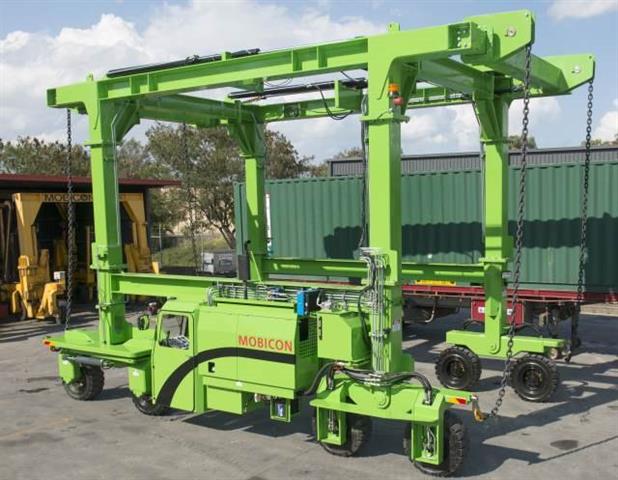 The Eco B Straddle Carrier. Click for larger image |
When buying a Small Straddle Carrier (or Mini Straddle Carrier as they are called at Mobicon Systems) to handle your containers, the suitability of the yard to handle the wheel loadings is often overlooked.Mobicon Systems understands the large costs of repairing damaged yard surfaces, and therefore all of
Mobicon's Straddle carries have 8 wheels to lower the wheel weights and therefore avoid cracking of concrete and breaking of bitumen surfaces. All other 'Mini' Straddle Carriers on the market have four wheels, with some even having only three, and therefore have at least double the wheel weights of a Mobicon.
Mobicon Systems engaged an independent Civil Engineering Firm to assess the effects
Mini Straddle Carriers have on an average industrial yard surface.
The Report used the Australian Codes and Technical Design Guides such as C&CAA and Austroads for pavement structural design.
Summary of the report:Compared are various 8-wheel, 4-wheel and 3-wheel Mini-Straddle Carriers and their effect on concrete slabs.
- The major concern to the pavement design is the wheel point load which generates the critical stress to the pavement.
- Based on literature review for industrial pavement, the traditional pavement thickness would be ranged from 150mm to 200mm.
- This pavement thickness will be generally adequate for the 8-wheel Straddle Carrier, even with a 35t lifting load.
- However it becomes inadequate for the 4-wheel and the 3-wheel carriers, even with a reduced load of 26t. The pavement will be damaged if the 3-wheel or 4-wheel carriers travel and operate on it.
- Cracking (of the concrete) will start from the bottom and may start from the first time of overloading.
- The rectification of pavement will involve major works, and is time consuming and costly. After 3 years, a 200m2 repair could cost $35,000.00, and the new concrete has to cure for 28 days before it can be driven on.
There can be confusion between wheel weight and tyre pressure. Some Straddle Carrier manufacturers claim that larger wheels reduce the pressure, and thus will not damage the concrete. This is disputed in the report, as the wheel weight is the cause of damage and not the pressure, according to the engineers, using bigger wheels will not help to reduce damage to the concrete.
A simple analogy will support this. A long bridge, that has a weight limit of say: 10t will have a sign; maximum vehicle weight 10t. You will never see any signs that give pressure limits. Whether a vehicle has small or large tyres, the bridge will get damaged if the weight of the vehicle exceeds 10t.
Don't be fooled by the concrete "looking ok" or by claims of: "large tyres will not damage the concrete". When in doubt, get advice from a reputable Civil Engineer. It will help you to make an informed decision and will save a lot of money in the long term.
A DEMONSTRATION
In order to explain clearly the difference between wheel weight and wheel pressure we have the following demonstration:
A cone is placed on a ruler - the surface area at the bottom is 270 times larger than the surface area at the pointy end. Therefore, when the cone stands on the ruler with the pointy side down, the pressure is 270 times higher. You will note, that regardless of which way the cone is placed and therefore regardless of the pressure, the bending of the ruler is exactly the same. This proves, that a high or low pressure does not make any difference to the breaking of the ruler (read concrete). It is the weight that makes the concrete break. Not the pressure.
The next two images are a simulation of a wheel of an 8-wheel straddle carrier (the small one) and a wheel of a 4-wheeled straddle carrier (the big one). The pressure of the two wheels is exactly the same, as the smaller wheel has half the weight, but also half the contact area. Placing the small wheel on the concrete makes it bend a little. Placing the large wheel on the concrete makes it bend a lot more. This again proves, that it is the weight that makes the concrete break, and that using larger tyres is not a solution to avoiding concrete damage.
For any enquiries about a Mobicon Mini Straddle Carrier please visit our website www.mobiconsystems.com or see below:Colin Francis - General Manager, Business Development
Mobile: 0437 335 951
Telephone: +61 437 335 951
Email: send an email
Website: www.mobiconsystems.com